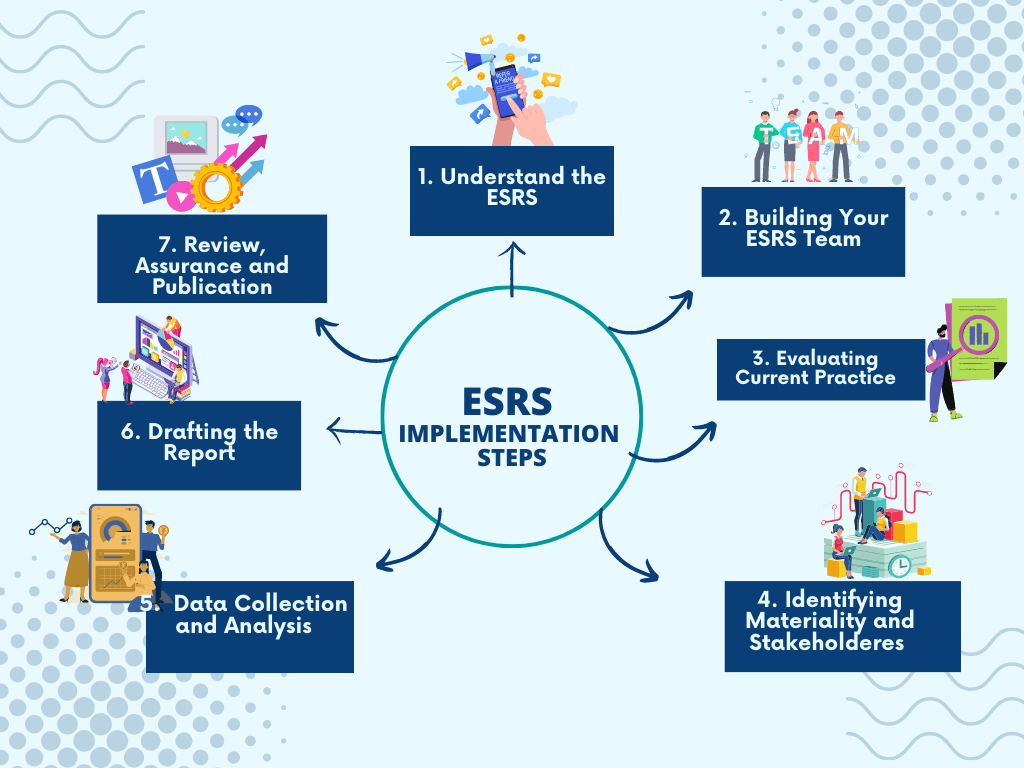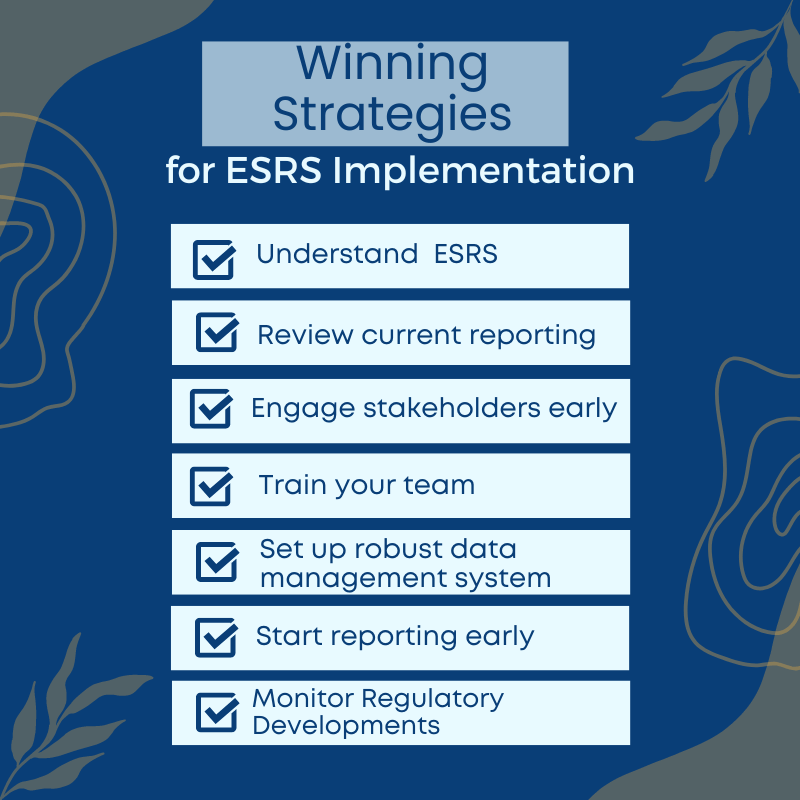What are the EU Sustainability Reporting Standards (ESRS)?
The EU Sustainability Reporting Standards (ESRS) are proposed guidelines that aim to standardize and improve sustainability reporting by companies operating in the EU. The first set of draft ESRS were developed by the European Financial Reporting Advisory Group (EFRAG) for the European Commission (EC) and will affect corporate reporting and governance practices. Compliance with these disclosure requirements will have an impact on companies’ ability to demonstrate their sustainability performance to stakeholders.
The ESRS are expected to become mandatory under the Corporate Sustainability Reporting Directive (CSRD). The first set of 12 draft ESRS stanards were published November 2022 and adopted by the EC on July 31, 2023. The standards include reporting requirements on various sustainability matters, including carbon emissions, environmental and social risks, and the impact of business activities on stakeholders. The implementation of ESRS is expected to provide consistent, high-quality sustainability data and ultimately lead to more informed decision-making by investors, regulators, and other stakeholders.
What will the European sustainability reporting standards mean for businesses?
The new ESRS are set to create a significant impact on businesses, as they will establish the requirements and guidelines for sustainability reporting and disclosure. As a result, companies subject to the CSRD will need to prepare and publish their annual sustainability report or sustainability statement in compliance with these standards. The ESRS will also play an essential role in promoting the sustainability governance of companies, providing them with a framework to assess and report on their sustainability performance.
This shift to uniform reporting will help investors make informed decisions based on comparable information on companies’ ESG performance. By 2024, EU member states are expected to adopt these standards, and businesses that fail to comply will risk facing reputational damage and financial penalties. Overall, the ESRS will not just increase transparency from businesses but also promote sustainable practices and enable stakeholders to understand the long-term impact of their actions.
Meeting ESRS Requirements: A Step-By-Step Guide for 2023
Embarking on your sustainability journey? Learn how to implement the European Sustainability Reporting Standards (ESRS) seamlessly with our detailed step-by-step guide for 2023.

Step 1: Understanding the European Sustainability Reporting Standards (ESRS)
Start by familiarising yourself with the ESRS, their objectives, and relevance to your corporate sustainability reporting. Visit the EFRAG website and read through the draft European Sustainability Reporting Standards, ESRS board notes, and other relevant materials to understand the basics. The ESRS aims to improve transparency and consistency in sustainability reporting across Europe, making it easier for stakeholders to compare and assess organisations’ sustainability performance.
To develop a thorough understanding of each ESRS requirement and their interconnections, consider subscribing to the comprehensive ESRS courses offered by The CSRD Compass. It’s an efficient way to enhance your knowledge base while saving time.
Step 2: Building Your ESRS Team
Next, assemble an ESRS implementation team comprising ESG professionals within your organisation. This team should include representatives from different departments, such as finance, legal, data, sustainability and operations. Members should understand the importance of ESRS and be committed to ensuring its successful implementation. Regular meetings should be scheduled to review progress and address any emerging issues.
Step 3: Evaluating Current Reporting Practices
Before you can adopt the ESRS, it’s essential to evaluate your current sustainability reporting practices. How does your existing report compare with the ESRS requirements? Evaluate the existing sustainability reporting process, identifying gaps between your current practices and the ESRS can help you understand what changes are needed.
Step 4: Identifying Materiality and Stakeholders
Under the ESRS, you’re required to report on material sustainability matters following the double materiality approach on top of the mandatory disclosures (See ESRS 2 for more information). These material matters are topics that reflect your organisation’s most significant economic, environmental, and social impacts, or those that could influence stakeholders’ decisions. Identify these topics and engage with your stakeholders to understand their perspectives and concerns. This step will ensure that your sustainability report is relevant and useful to your stakeholders.
Step 5: Data Collection and Analysis
Once you’ve identified your material sustainability topics, you’ll need to gather and analyse data related to these topics. ESRS provides a single configuration for data collection and reporting to ensure consistency and comparability. Implement data collection processes that align with these standards and make sure to verify your data’s accuracy and reliability.
Step 6: Drafting Your Sustainability Report
With your data in hand, it’s time to draft your sustainability report. Follow the ESRS guidelines on structure and content to ensure your report is consistent with the standards. Make sure that the reported information meet the qualitative characteristics of information as outlined in the ESRS 1: General Requirements. For a detailed discussion on this topic, check out our General Standard Course.
Step 7: Review, Assurance, and Publication
Finally, your draft report should undergo a thorough review to ensure it meets all ESRS requirements and accurately reflects your organisation’s sustainability performance. An external audit or assurance process is required under the CSRD. This audit can enhance the credibility of your report. Once assured, publish your report on your corporate website and share it with your stakeholders. Ensure secure remote access to your report for easy viewing.
The implementation of ESRS is a journey that requires commitment, collaboration, and transparency. With these steps, you’re well on your way to improving your sustainability reporting practices and meeting the ESRS requirements. Remember, the goal is to foster better sustainability practices and contribute to a more sustainable and inclusive economy. Begin your journey today.
Your Next Step on the CSRD Compliance Journey
Are you ready to spearhead your company’s sustainability journey and stand out from the crowd? The Corporate Sustainability Reporting Directive (CSRD) and European Sustainability Reporting Standards (ESRS) are not only coming but are here, and your next steps are critical.
Mastering the complexities of the CSRD and ESRS can seem like a daunting task. However, overcoming this challenge doesn’t just mean compliance with new laws – it’s an opportunity to show your commitment to a sustainable future, to gain a competitive edge, and to attract stakeholders who value responsibility.
We know it might be overwhelming, but you’re not alone in this journey. Imagine having all the necessary tools, knowledge, and support at your fingertips. That’s where The CSRD Compass steps in. We’re your ultimate guide to everything CSRD and ESRS, offering a rich collection of resources ranging from detailed guides and insightful articles to comprehensive courses and expert analysis. Navigating this new terrain of sustainability reporting has never been easier!
Don’t wait for tomorrow. The time to act is now. Embark on your sustainability reporting journey today, prepare your business for a sustainable future and make a real impact on our planet. Visit The CSRD Compass today, and let’s shape a greener future together!


